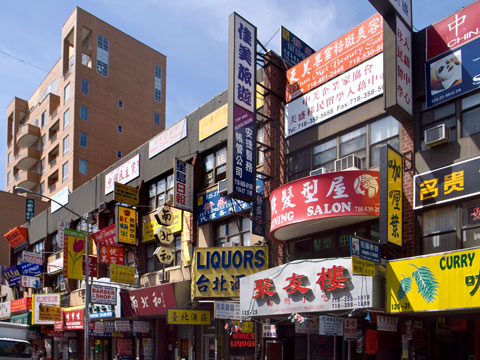 Reading Arthur Miller's memoir about his 1983 production of Death of a Salesman makes me realize how much American culture has changed since then and perhaps even how diverse Montgomery County is. Indeed, Miller observes, "[the actors] are simply the-Lomans-as- Chinese-looking people. This places them in some country of the mind, not in any earthly geography" (172). Could one say this about the New York and Boston of *our* today, to use Miller's stage directions?
Reading Arthur Miller's memoir about his 1983 production of Death of a Salesman makes me realize how much American culture has changed since then and perhaps even how diverse Montgomery County is. Indeed, Miller observes, "[the actors] are simply the-Lomans-as- Chinese-looking people. This places them in some country of the mind, not in any earthly geography" (172). Could one say this about the New York and Boston of *our* today, to use Miller's stage directions?
The picture above is of Flushing, a neighborhood in NYC's borough of Queens.
 The picture above shows actor B.D. Wong who plays a detective on Law and Order: SVU. As you may know, this show is set in NYC.
The picture above shows actor B.D. Wong who plays a detective on Law and Order: SVU. As you may know, this show is set in NYC.However, back in 1983, the Beijing production of Death of a Salesman was groundbreaking. Although it had been just over ten years since Nixon's visit, China was emerging from a period of isolation and recovering from its Cultural Revolution. (Miller makes many observations about the impact of this historical period on the Chinese, especially on the actors he works with and the intellectuals he meets.) The production of Death of a Salesman was therefore part of China's emergence and the development of its theater. (Miller also notes that his play's approach to time and space was novel to the Chinese. Most Chinese plays emphasized "realism" and a moral message over interiority and memory. Ironically, Western scholars such as Robert Brustein criticized Miller for his concern with politics and society.)
For more information about China's history and the Cultural Revolution, see these sites:
Miller also discusses his Chinese actors' approach to theater. It is more physical than Westerners' reliance on psychology and motivation. In fact, Miller is mystified and annoyed by his actors' desire to wear wigs and therefore appear more "Western." Finally, one actor reveals to him that Chinese actors enjoy dressing up and feeling that, by changing their appearance, they may "change their fate." Nevertheless, Miller is concerned about the effect that the actors' attempts to look "Western" may have on his play's realism. It is also amusing to read Miller's complaints about the 1940's long skirts.

At this point, you may wonder whether the play was performed in English or Chinese and whether Miller knew Chinese. The play was performed in Chinese. The actor playing Willy, Ying Ruocheng, also translated it, and Miller was quite pleased with this translation. Miller did not know Chinese. His wife, the photographer Inge Morath, did, having studied the language for eight years. Miller also relied on several other translators, especially Ying Ruocheng. Moreover, this was not Miller's first trip to China, and he and his wife had hosted many visitors from that country (including Ying Ruocheng).
Here is a picture of the cast of Death of a Salesman with the play's author.
 Below is a picture of Ying Ruocheng in another role. I will try to find out which one it is.
Below is a picture of Ying Ruocheng in another role. I will try to find out which one it is.  He, too, has written an autobiography, so I guess I have something else for my summer reading!!
He, too, has written an autobiography, so I guess I have something else for my summer reading!!As I close, I wonder what Arthur Miller would have made about the Oberlin production of Death of a Salesman starring Avery Brooks.

2 comments:
The view of the Chinese productionof Arthur Miller's play is reminding me
of recent photos by Andre Cartier Bresson in Chicago at the Art Museum
of factory workers in Beijing, and of children who are deaf...it was an
exhibit of photos from 1960's...and the recent china, the Mao era was
made evident. Thanks about the Chinese History...at MFA is an exhibit
on Fresh Ink, of old and new art by Chinese artist...one artist
compared his ink on parchment scroll to a Jackson Pollack...
the ink on scroll was of a rolling landscape and quite beautiful.
Oh how wonderful that the MFA has an exhibit on Chinese art!
Post a Comment